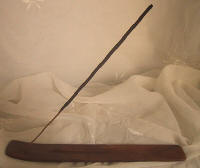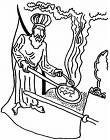
|

History
______________History of Incense Page___________________
Here you will find the History of Incense.
|
|
Incense is.....
Incense is a preparation of aromatic plant matter, often with the addition of essential oils extracted from plant
or animal sources, intended to release fragrant smoke for religious, therapeutic, or aesthetic purposes as it smolders.
In the past, Chinese and Japanese society used incense as a time keeping device in the form of incense clocks. It has
been popularly used for thousands of years within India as an integral part of Hindu deity worship. Furthermore, it holds
an important usage in Buddhism and, to a lesser extent, some Christian denominations
|
 |
The five Elements
Incense Ingredients
Breaking down the five elements and their Ayurvedic relationship to plants and common incense ingredients we find them
falling into five classes. The following chart shows the relationship:
1. Ether (Fruits) Star Anise
2. Water (Stems & Branches) Sandalwood, Aloeswood, Cedarwood, , Cassia, Frankincense, Myrrh, Borneol
3. Earth (Roots) Turmeric, Vetivert, Ginger, Costus Root, Valerian, Spikenard
4. Fire (flower) Clove
5. Air (leaves) Patchouli
|
 |
Click on the picture above to buy a Dozen today.
Incense has appeared in many forms: raw woods, chopped herbs, pastes, powders, and even liquids or oils. What most of us
think of as incense today is joss-sticks or cones. Cones as we know them were an invention of the Japanese and introduced
at the World's Fair in Chicago in the late 1800's. I cannot say, at this time, when the Joss Stick or Masala incense first
appeared. We do know that it was brought to China by Buddhist monk's around 200 ce.
|
|
|
History of Incense
Incense, has been known to mankind's for centuries. first experiences with fire itself. It is unlikely primitive man
would have missed that certain woods had more pleasing aromas and indeed varying emotional effects. Incense artifacts,
thousands of years old, have be found in throughout the world, and appear to be a part of virtually every culture. The
connection between incense, religions, medicine, and shaman practices is obvious, it would be impossible to separate them,
or say which proceeded the other. Historically it is difficult to trace because it has always been largely an esoteric and
oral tradition evolving in relation to both religion and medicine.
|
|

There are many myths regarding incense as well. Several modern sources include the use of Salt Peter (Potassium Nitrate)
in making incense. This is undoubtedly a much later addition that arose in the commercialization of incense, primarily in
the last 40 years.
|
|
|
|
|
|